Francesca and Henk-Jan's Backpacking Trip!
Sunday, March 21, 2010
A Pitstop At The Plain Of Jars In Phonsavan
Next, we went to talk to the tout that had taken us from the airport to town, Vongsavath of the Inter Lao Travel Agency. He offered us some standard Jars-tours, as well as one including a trip to a newer site that had only recently been opened. We decided to hold off on the decision for a while, whilst we explored the one street of Phonsavan. We had read about the large number of bombs and UXOs (Unexploded Ordnance) that were dropped by the Americans during the Secret War. Seeing them standing around as decoration, however, made it apparent just how abundant these remnants of war are.
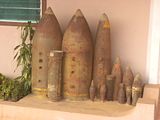
Francesca and I headed over to the UXO Information Center where the full extent of the Secret War became apparent to us. Xieng Khouang, the province we were in, was covered in 1.3 million ton of ordnance between 1964 and 1973. Up to 30% of some of the different types did not explode, still killing people across the province. Northern Laos was bombed because large areas were controlled by the Pathet Lao, the communist regime at the time which supported Communist Vietnam; Southern Laos was bombed mainly to disrupt use of the Ho Chi Minh trail, which was used by the Vietnamese to smuggle goods and equipment from North to South Vietnam. In total, there are still hundreds of thousands of UXOs covering the country.
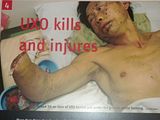
Since the war ended there have been over 50,000 recorded deaths due to UXOs. Furthermore, countless people lost limbs and were disabled for life. Almost half of the victims are children, who might see the bombs as toys or food. We saw some gruesome pictures of the harsh reality that is daily life on the countryside here. Francesca and I were also amazed how little the Americans have taken responsibility for their actions, as we found most of the UXO-clearing is funded by humanitarian organizations and countries that had nothing to do with the Secret War (amongst them almost everywhere the Dutch!). A British organization called MAG has even set up teams of local tribes’ people that have been trained to be expert bomb removers. We finished the impressive visit by watching the documentary ‘Bombies,’ which shows the aforementioned in every detail. Shocking to see!
We returned to the travel agency and booked the Plain of Jars tour for the next day, and had Indian (yes, again!) at the local Nisha restaurant. So good! We headed back around the corner to the White Orchid and slept in our comfy room.
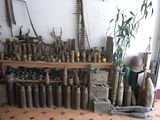
The next day we woke up around 8:00 AM for our free breakfast, which consisted of a baguette, an omelet and a cup of tea. We took our time and went to the office of the travel agency just before 9:00 AM. We were met by Tuwi, Vong’s brother and soon started our tour.
There’s over 50 different sites with jars, but only a few of them have been cleared of UXOs, so the options are fairly limited. It’s also the reason why the Plain of Jars is not yet a World Heritage Site. The MAG is working on clearing some of the more spectacular sites, but they’re obviously more interested in helping the people of the countryside out, since they’re the ones that have to work their paddies every day, risking their lives every day. Francesca and I realized the two-fold problem this presents: helping to clear the Plain of Jars will up tourism, improving life; cleaning the farms of UXOs makes life for the villagers safer, ups their production and will in the long run also improve their lives. Not an easy choice to make, so MAG divides its attention.
We started our trip to the Plain of Jars with a visit to the information center, where we had a look at some scrap from the war, ranging from small ‘bombies’ to giant fuel tanks from planes. We then drove to Site Two, which consists of 2 hills with a total of about 90 jars. When we heard ‘cleared of UXOs’ we didn’t think there’d only be a pathway to the jars, which we HAD to stay in between. When we got to the top of the first hill we spotted the first jars and Tuwi started explaining a little about the history of the jars. As the Lonely Planet summarizes: “The purpose of these possibly 2000-year-old jars remains a mystery and without any organic material – such as bones or food remains – there is no reliable way to date them. Archeological theories and local myth suggest the enigmatic jars were used for burial purposes – as stone coffins or urns – or maybe for storing Lao-Lao (rice whiskey) or rice.“
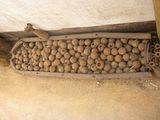
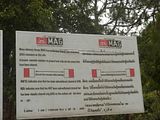
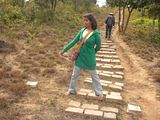
Francesca and I started thinking about the puzzle and came up with the idea they had some religious purpose, but we couldn’t quite figure out what they were used for. Burial seems unlikely since they haven’t found any bones, other than some found by a Frenchman in the 1930s which mysteriously disappeared. Storage also seems improbable since some of the jars were too big for me to reach in. Furthermore, we thought the people that made the jars must have had hides to store food in. Interesting nonetheless! We took some nice pictures with the pots, carefully looking around for any UXOs. We even saw one huge crater right next to a few of the jars, which meant the bunch around us got lucky!
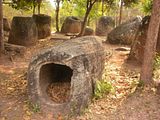
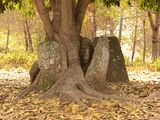
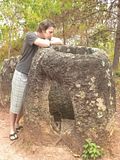

Tuwi took us to the second hill as well, and here we found more examples of the giant stone cookie jars. The highlight here was not a jar though: Tuwi showed us an old lid, once used to cover the contents under it. The top had an interesting carving of what might be a human figure. Standing on the hill we also noticed our hilly surroundings: very brown due to the dry season, but still very scenic. On our way back to the van we spotted a broken jar, which meant we could take a picture of the inside of the jar. Obviously Francesca climbed in the jar, careful not to damage anything, and I took a few cute pictures of her!
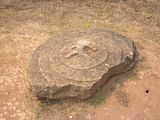
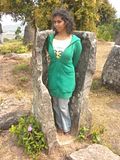
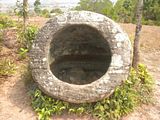
Our second jar site of the day was the newly opened and thus UXO-free site 16. It took quite a while to drive out there on the dusty and bumpy roads, but it proved to be worth it. Unlike the jars at site 2, which are made of sandstone, these jars were cut out of granite. The surroundings were also a little different, with there being a bunch more trees around. We had a look around, checking the contents of the jars, and realizing the only difference with site one was the absence of rubbish. Most jars here actually looked a little more ruined, and were actually not much more special than the other 90 we had already seen. What made the visit worth it became apparent in the final jar we checked… It contained a dead cat! Francesca wanted loads of pictures, so for those a little faint of heart: please ignore the following picture.
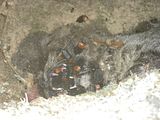
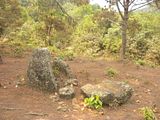
After kicking up a bit of sandstorm on our way down from site 16 we headed to Meuang Khoun, the old capital of the region. We had hoped for a more spectacular view, so just seeing one old Buddha was a bit disappointing. The temple, Wat Phia Wat, was bombed during the war and whilst the temple itself was destroyed the Buddha remained largely intact. Some shrapnel had damaged the face and some part of the left arm, but otherwise it looked in mint condition. I took some close-up pictures of the face before we headed for lunch.
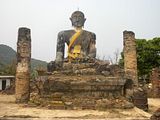
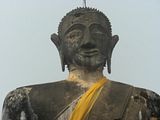
Lunch was served in a local restaurant by the side of the road. Pho (noodle soup) is a Laotian’s breakfast and lunch favorite, so Francesca and I got the chicken and duck Poh respectively. It came with a large plate of lettuce and mint leaves, as well as a tasty peanut sauce. On top of that we got a bunch of bananas to eat with it! The food got us re-energized and we left for our next stop.
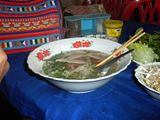
The That Found Stupa was built during the 14th century by a local king as a funeral shrine. On a small hill opposing his hill another Stupa can be found for his wife. When the kingdom fell and the Vietnamese came upon the Stupa they thought they might find great treasure under the massive stone structure, so they made an entire tunnel through the Stupa. They also made several large openings on the side, but to no avail: the Stupa was empty. Many centuries later the Stupa is now covered in grass and looks quite unique compared to many other Stupas we have seen on our travels.
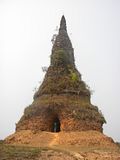
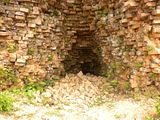
Our tour also included some visits to villages along the way. We made a short stop at Phouan village, inhabited by Lao Loum people, as well as Hmongs. These people have found creative ways of using the UXOs to their advantage: the village smith makes all sorts of tools out of the shrapnel, and the bombs are used as lamps or as extra support for their houses. We also visited the Thai Dam (Black Thai) village, where the locals still make most of their money through weaving. We learned that a proficient weaver can make about a meter and a half per 6 hours, which can then be sold for between US $6 and $10. The girls work from sunrise to sunset, with only a short 30 minute break for lunch. You don’t need to be a genius to figure out that that’s pretty poor pay for a lot of work! I felt bad about not buying anything, but at this point our backpacks are still of an acceptable weight and we want to keep it that way.
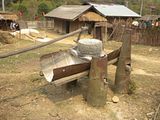
Around 2:20 PM we reach our final destination for the day: site 1, the biggest site of all with 334 jars. It’s also home to the largest jar of them all, which has a diameter of 2.5 meters and is 2.57 meters high. We walked uphill to the first cluster of jars and took more pictures. Signs around us made us aware of the old trench lines used during the war. In the distance we could also see a large selection of more jars. We walked downhill towards them, passing several craters along the way. Tuwi first took us into a large cave which was used as a shelter by the locals during the war. Old water tanks can still be seen on the floor, even though the years have caught up with them and they’re now covered in rust and dirt.

We headed back outside and walked towards our final selection of jars. Some had filled up so far with dirt that there were now plants growing out of them. Others still had stagnant, smelly pools of water in them. Others had broken altogether, and looked like piles of rubble. Tuwi showed us a special jar here, with a drawing of a human on it. It’s the only jar out of the many hundreds in the region that has any form of drawing on it. It’s uncertain why this jar has the art on it, but researchers guess it might just have been the sculptor who wanted to add a little extra to his creation. Tuwi also showed us another lid, which had been put on top of a jar by some local kids years ago. They’d put the lid on the wrong way around, which shows how the bottom of the lid has multiple rings on it. The rings were used for jars of different sizes, making the lids multi-functional. Smart!
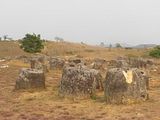
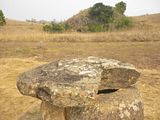
Our jar-time was drawing to an end since we didn’t want to stay until sunset (which the tour promised it would show us), which was still 3 hours away. We were both pissed off that we hadn’t done the entire itinerary, and were unpleasantly surprised to hear we’d just be dropped off at site 1 to wait for sunset and then be picked up 3 hours later. Not the best way to impress your customers! We headed back to the car, whilst Tuwi told us why some of the craters have extra smaller craters in the middle of them: locals had come in and tried to dig up any remaining shrapnel to sell for cash. Not without danger since parts of the cluster bombs could go off when hit by shovels or when stepped on.
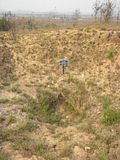
We headed back to town and tried to talk to Vongsavath, but he had mysteriously disappeared. When we asked when he’d come back we just heard he’d be back ‘later’. We decided to go for dinner first, and found a nice little restaurant called ‘Craters’ with both Laotian fair and Western food. We got takeaway, me opting for the chicken laap and Francesca bringing back a chicken fillet. We had to wait a long time for our food to arrive, which then turned out to be very small portions. On top of that they didn’t taste fantastic. Francesca fillet was the flattest of patties, hard to chew and her fries were soggy. My laap was decent, but the rice was old and the pieces of chicken few and far between.
The morning of the 19th Francesca and I tried to get in touch with Vongsavath again, but he’d just gone to the hairdressers, and then to the airport… We realized we wouldn’t see him anymore. Instead we decided to go for Indian at the local Nisha, where a Chicken Tikka Masala and Chicken Palak were a welcome replacement for last night’s culinary disaster. We found a tuk-tuk to take us to the airport and left Phonsavan around 3 PM, returning to Vientiane 30 minutes later.
We contemplated leaving that same evening to go to Pakse in the south of Laos, but we didn’t have enough time to book a ticket. We checked in for one more night at the Lakeo Belle Villa and slept like babies, before waking up on the 21st to buy tickets to Pakse. We knew this drive would take about 12 hours, and that there’d be sleeper buses available so we headed to the center of Vientiane and looked for travel agencies. Unfortunately, on Sundays they are all closed… Unsure of what to do we walked into the JoMa Bakery to share a banana split and order some sandwiches to bring back. We had heard we could just wing it and go to the bus station by ourselves. As we went to find a tuk-tuk to take us back we spotted a travel agency that was open! And it sold tickets to Pakse! We booked our tickets for later that evening, headed back to Lakeo and relaxed for a few hours before we were picked up. Francesca will tell you all about the sleeper bus and our adventures in the south!

1 Comments:
Hey Fran!! dank je wel voor je verhaal, iets minder heftig dan Vang Vieng... ff bijkomen weer, of niet dan? Kus Gina
Post a Comment
<< Home